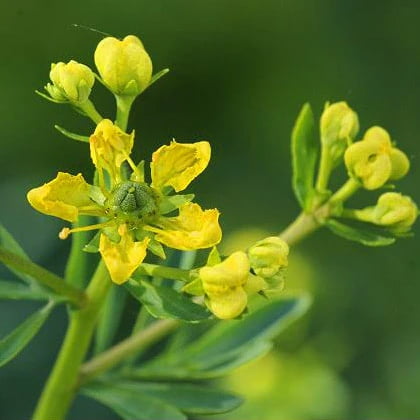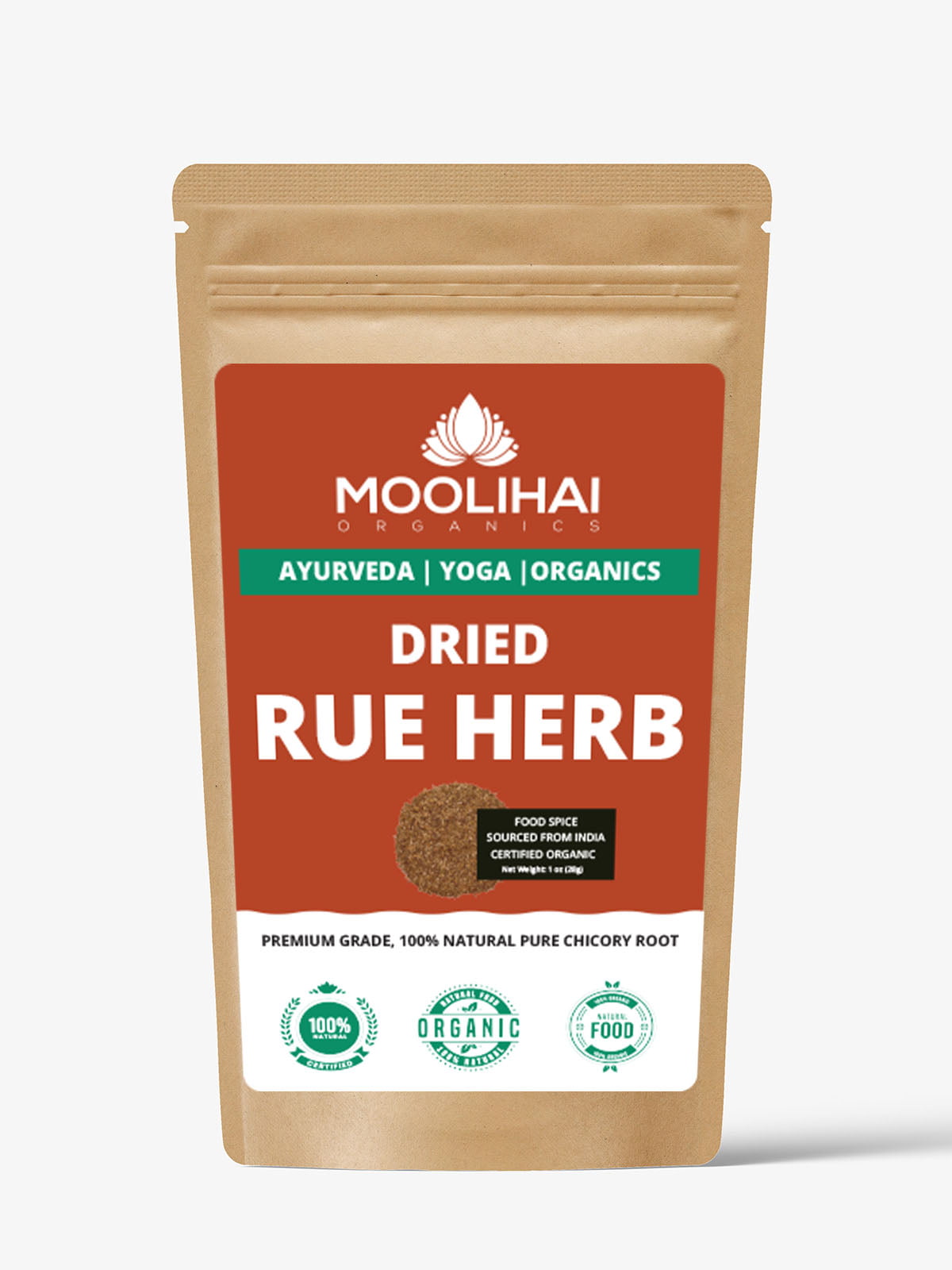Info
What are the health benefits and uses of Ruta Graveolens?
What is Rue?
Rue is a hardy, shrubby, and evergreen plant which is used to make medicine. The native of this plant is the Mediterranean region and the Canary Islands. You can also find this plant on rocky places, dry banks, limestones, and thickets. The stem is located on the lower part. Leaves are bi or tripinnate that comes in bluish-green color, emitting a powerful and unmistakable odor with a very bitter, pungent, and nauseating taste. The flowers are greenish-yellow terminal panicles and bloom from June to September. The small green subshrub is 0.6 to 0.9 m high and almost wide. Each flower is 1.3 cm long and has four concave petals. The fruit is a hard capsule.
Don’t confuse rue with goat’s rue and meadow rue. As it has safety concerns, rue is used as a medicine. It can give relief from digestive problems, including loss of appetite, abdominal pain, and diarrhea. You can also use this herb for heart and circulation problems such as the hardening of the arteries.
Some people use rue to treat respiratory problems, including pain and coughing due to inflammation around the lungs (pleurisy).
Ruta graveolens is the best medicine to cure some painful diseases like headaches, joint pain, muscle cramps, as well as nervous problems like anxiety, epilepsy, multiple sclerosis, and Bell’s arthritis.
Some people used this herb for hemorrhage, fever, hepatitis, eye weakness, water retention, and oral cancer. Moreover, it also kills fungus and bacteria. Some ladies used this herb for menstrual issues and provoked the uterus to cause miscarriage.
If you want the flavor, you can use the ruta oil in your foods and beverages. In production, rue oil is used as a fragrance in soaps and cosmetics.
Are there any Interactions with Medications?
If you are taking-in any medicine, you should consult with your healthcare provider before consuming rue gravelones.
Other Language Names of Ruta Graveolens
- Scientific Name(s): Ruta bracteosa L., Ruta chalepensis L., Ruta graveolens L., Ruta montana L.
- English name: Common rue, Rue, Garden Rue, Herb of grace, rue
- Hindi name: Rue, Sudab, Sadabin, Sanool, Saatri
- Tamil name: Aruvatham Pachai
- Swedish name: vinruta
- Portuguese name: Arruda
- Greek name: Fejan, Safayan
- French name: Rue fétide, rue officinale
- Persian name: Satap
- Transcribed Korean name: unhyang
- German name: Wein-Raute, Weinraute
- Arabic name: Sudab, Suzab
- Spanish name: Ruda, Ruda de monte
- Urdu name: Sudab
- Sanskrit name: Sadapah
HISTORY OF RUTA GRAVEOLENS
Rue is a well-known plant for its medicinal properties. Aristotle said that it is necessary to suppress tension. Pliny recorded that artists used it to promote eye health. When built in clusters, this plant is also called the “herb of grace,” is used to sprinkle holy water on churches and cathedrals. It was sprayed on the bases of the courts by the judges in order to stop the disease. Because the imprisoned poor people were often affected by plague. The word “rue the day” comes from the awkwardness of dealing with the leaves of Ruta graveolens.
The native of the Ruta graveolens is southern Europe, northern Africa as well as the Mediterranean region. This hardy evergreen shrub has established itself throughout the continent with the help of British and Spanish colonies. It has become a staple of cottage gardens in the West Indies, Mexico, the United States, and India. It is now a natural member of North and South American plants and thrives easily in USDA 6 to 11 growing zones. Its flower is yellow in color, and the stems are green-grey, and you can find the leaves in medicinal and culinary herb gardens. (Source)
PROVEN HEALTH BENEFITS OF RUE HERB
As per the Natural Medicines Comprehensive database, Ruta graveolens possess alkaloids that have anti-fertility, antispasmodic, antihistamine, and anti-inflammatory properties. Moreover, it also has a rutin compound, which has antioxidant properties. This property prevents you from radical damage.
Rue oil is used as a fragrance in cosmetics and soap products. As it has toxicity, rue is occasionally used in the skin directly. However, Ruta graveolens provide some skin benefits.
1. Antifungal
Ruta graveolens can fight against fungal and bacterial infections like athletes’ feet and dermatitis. Based on the infection severity, Ruta can be applied to the skin directly. Furthermore, it gives instant relief from itchy skin.
2. For Clear Skin
As it has antifungal properties, it can cure the de-complexion of your skin and gives clear and glossy skin. Rue’s antioxidant properties prevent free radicals from causing premature aging of your skin and maintains your skin younger and happier. That’s why rue oil is used in spas to provide therapeutic facial vapors.
3. For Lice Free Hair
Rue essential oil and extracts have an effective insecticide that helps to get rid of a lice infestation. If you are using rue oil regularly on your hair, it will repel the parasites and prevent your hair from itching.
4. Get a Spa Treatment
Most of the famous spas use rue oil for hair treatment. It gives shine to your hair and keeps your hair more healthy. It is one of the best treatments for healing damaged hair.
5.Sedative
Rue is effectively working for epileptic and hysterical attacks as it has sedative properties. It stimulates numbness due to neurotoxin content and, at the same time, helps to soothe and relax the nerves.
6. Insecticide
Generally, cockroaches, mosquitoes, and flies cause several diseases like malaria, dengue, and other virus fever, etc. With the help of ruta, you can destroy these insects. You can also use this herb as incense sticks, vaporizers, burners, fumigants, and ward off insects.
7. Antibacterial Property
This property is used to eliminate bacteria. The tea prepared by rue can treat urinary tract infections, intestine infections as well as the colon. In addition, it helps to prevent salmonella and food poisoning chances.
8. Antispasmodic
If you are suffering from muscle pain, then Ruta graveolens is the best medicine. Not only used for muscle pain but also to get rid of anxiety and menstrual cramps.
9. Anti Inflammatory
Intaking 1 to 2 cups of Ruta tea regularly gives you stiff muscles and also provides instant relief from joint pains. It lowers the inflammation caused by arthritis.
10. Remedy for Poison
Rue is widely known to be a trigger for poisoning. It is very effective in neurotoxins, but it does not show any effect on hemotoxins. It is one of the best remedies for snake bites, insect bites.
Medicinal Uses of Aruvatham Pachai (Rue)
The plant extract can cure earaches.
You can use this herb for frantic infection, cough, flatulence, colic infection and acts as a stomach reliever.
For severe pain of sciatica, apply the leaves.
If you want to get relief from headaches, apply the fresh leaves on your forehead.
To cure chronic bronchitis, apply the plant decoction on your chest.
You can get rid of dermatitis, inflammatory diseases, eye problems, and pain, through this herb.
Rue with honey helps to cure tremors, strokes, nerve disorders, and joint pain.
The decoction of the aruvatham pachai is used to cure gastroenteritis, flatulence, and colitis.
To treat infantile paralysis, you can use the leaf infusion like a nasal drop.
Use it as a poultice form for varicose veins, dislocations, tendon strains, rheumatic pain, and skin conditions like eczema and psoriasis.
Want to stimulate menstruation, then intake the decoction of Ruta herb.
For gastric disorders, dizziness, headache, and stiff neck, you can use it.
The infusion treats the cough, flatulence, and hysterical affections.
If you have nervous headaches, palpitations, and giddiness, then chew the leaves to get relief from those issues.
Ruta helps to increase your eyesight and treats varicose veins.
To kill lice, use the brewed tea (made from leaves) as a body wash.
As it has antifungal properties, it can treat fungal skin infections like athlete’s foot and dermatitis.
It also helps you to get rid of stomach cramps and removes intestinal worms.
Culinary Uses of Sudab (Ruta Graveolens)
- Rue seeds can be used as porridge (breakfast)
- In Olden days, rue acts as a flavoring ingredient in beers.
- In North African cuisine, it is used as a cooking ingredient.
- Take the bitter leaf, egg, fish, cheese, and wine. Mix all of them to produce meat sauce.
WHAT IS RUTA USED FOR IN HOMEOPATHY?

Ruta Graveolens is one of the homeopathic medicinal plants. Generally, homeopathy treatments are followed by the ‘like cures like’ principle.
Ruta graveolens is a strong, intelligent evergreen shrub with many homeopathic medicinal uses. The leaves and oil are used as a flavoring ingredient in many beverages.
It is an effective solution after surgery involving tendons, cartilage, connective tissue, joints, and bone sheaths.
The oil is used as a fragrance in cosmetics such as soaps, creams, and lotions.
You can use this herb as a first-aid treatment for stretched ligaments, injuries, sprains, bruises.
Rutin, a flavonoid that is a good remedy for eye problems.
It is used to give relief for pain and soreness in joints, cartilages, bones, and tendons.
Sprains or fractures can be treated well-using Ruta.
Ruta has many active compounds such as alkaloids, flavonoids, coumarin, and essential oil which is a good solution for low back pain.
The alkaloids and coumarin in the rue have antispasmodic properties.
If there is a deep stiffness in the joints and muscles after the surgery, it will ease the discomfort.
Siddha Uses
- In chronic bronchitis, the leaves can be used on chicken breasts.
- Ancient Siddha books have mentioned that it is used in epilepsy (baby dose 30 to 60 drops).
- You can also prepare a decoction using dried leaves and the dose that should be taken is upto 40 to 80 ml for adults.
- Traditional medicine also states that planting this herb repels the entry of snakes to your house.
- It is also believed that planting this herb in your home can prevent epilepsy(It is just a belief).
- Smoke from burnt leaves can be effective in treating childhood asthma.
- The water that soaks the ruta leaves prevents pests and flies. It is also used for stomach cramps. Moreover, it regulates menstrual flow.
- If you’re suffering from headache and nausea, then chew 1 or 2 leaves to get relief. You can also apply fresh leaf paste on the forehead for headaches.
- The infusion or decoction of crushed dried leaves (1 g to 6 g for adults) can relieve you from menstrual cramps, colic, diarrhea, intestinal infections, intestinal worms, epilepsy, fever, and cough.
- Applying the paste on the painful area like sciatica will give better results because the leaves contain antispasmodic and anti-inflammatory properties.
Note: It may cause side effects if you take it without a doctor’s prescription.





Health Benefits of Rue Essential Oil
The rue essential oil contains antibacterial, anti-epileptic, an antidote to poison, anti-hysteric, insecticidal, anti-arthritic, sedative, anti-rheumatic, anti-fungal, and digestive substances. The oil is extracted by the steam distillation of fresh rue plant. The essential components present in this oil are xanthotoxin, bergaptene, undecanone, butanone, psoralen, nonanone, and nonyl acetate.
1. Eliminates fungal growth
The rue oil has antifungal properties that can effectively stop the growth of fungus inside and outside the body. It can give protection against fungal diseases such as skin inflammation, skin discoloration, athletes’ foot and various types of food poisoning.
2. Antidote to Poison
Rue essential oil acts as an antidote for many poisons. The notable thing about this oil is, it is effective for neurotoxins but not for hemotoxins. This will help to counteract the toxins and induce vomiting if any toxins are ingested. It works well against narcotics and venomous snake bites like cobras and king cobras, insect bites, and stabs.
3. Antibacterial Properties
As rue essential oil has toxic nature, it can kill bacteria and prevent you from bacterial infections. If you’re taking it orally, then take in very mild concentrations under the supervision of a specialist. It also helps to get rid of food poisoning caused by bacterial infections such as Salmonella, bacteria in the colon, intestines, and urinary tract, and the skin.
4. Insecticidal
The next bright feature of the toxic properties of the oil is insecticidal. As it has a poisonous effect, you can use this oil to kill insects.
5. Promotes Digestion
The rue essential oil not only improves digestion, but also helps to give relief from indigestion and also the digestive issues that is caused by bacterial activities or infections.
Moreover, it can treat boils and warts as well as swelling that is caused by insect bites and stings. It is also used as a disinfectant.
Read also: 10 Common Digestive Herbs Naturally Boost Digestion
Note
You should carefully take the rue essential oil to your skin or eyes. You should avoid ingesting it, because its leaves can cause skin irritation. As it is abortifacient, it is not recommended for pregnant women.
Clinical Overview
Use
Rue extract is used as a potassium channel blocker. It helps to cure several neuromuscular problems and to regulate the onset of menstruation. Rue should be taken with caution as it has relatively low levels of antispasmodic effect. Rue may be used for serious adverse effects, but the clinical trials are limited.
Dosing
Ruta graveolens doesn’t have any clinical evidence to support strong recommendations. The traditional dosage of essential oil is 0.5 to 1 gram of herb or 65 mg that can be used daily. In large quantities, rue is an emulsifier, an aphrodisiac, and an abortifacient and is considered dangerous.
Contraindication
Ruta graveolens doesn’t have any contraindication yet.
Constituents
The volatile oil of this rue graveolens contains plagonic, oenanthic acids, caprinic, rutin, and caprylic. Moreover, it also has skimmianine that can be used to treat uterine issues.
Pregnancy/Lactation
Ruta graveolens is not recommended for pregnant and breastfeeding ladies.
Adverse reactions
Ruta graveolens extract contains mutagenic and furocoumarins that are combined with photosensitization. The rue oil can create damage to the kidney and hepatic degeneration whether you are ingested. If you intake a heavy dosage of Ruta graveolens, it will cause severe gastric pain, vomiting, and systemic difficulties, that can also lead to death. As it has possible abortifacient effects, it should not be ingested by women of childbearing.
Toxicology
Ruta graveolens must be taken only with high caution. A lawsuit was filed by a 78-year-old woman who took Ruta graveolens. After three days of use, the patient was admitted to the emergency department with bradycardia, hyperkalemia with severe renal failure, hemodialysis, and coagulopathy.
How to Make Rue Tea

Ingredients :
- Dried rue herb – 5 grams
- Water – 100 ml
Steps
Step 1: Take a sufficient amount of rue leaves. Ensure that you should wear gloves when you use the leaves, because there are some bruised leaves in the plant. The extract of the leaves or plant can spread in your hand. It can cause skin irritation. Cut the leaf using scissors and shift them into a plate.
Step 2: Spread the leaves on a plate and leave them to dry in the shade until it becomes smooth. The toxicity of the herb is slightly reduced when dried. Also there will be little loss of turbid oil in the herb while drying.
Step 3: Take the bowl and put around 0.5 grams of dried leaves. Boil them with 100 ml of water until it becomes lukewarm.
Step 4: After that, strain the drink and have it. You will get the strong smell of the rue leaves and it tastes bitter. The regular intake of this drink can treat inflammation and gives good relief.
Notes
The given dosage to prepare tea is safe. If you want a high dosage, you should consider your doctor.
Pregnant women must not intake rue herbal tea.
It is not suggested for babies and children.
Side Effects of Sudab (Ruta graveolens)
All the forms of the rue are poisonous, so you don’t ingest them directly. But the careful amount of the sudab can cure a myriad ailment. Some of the side effects are,
- Rashes
- Mood swing
- Spasms
- Stomach irritation
- Dizziness
- Without the carrier oil, don’t apply the substance to your skin directly.
- Carrying women should avoid all forms of rue because it may cause abortion.
- You should follow the doctor’s prescription before the intake of Ruta graveolens.
- Hope this article is helpful. You can give your suggestion in the comment section below.
- It is not recommended for stomach and intestinal issues like inflammatory bowel issues or ulcers, or colitis.
- People who have liver and kidney problems should not intake rue-related medicine and food. It may cause severe liver and kidney damage.






Ponnatharam Stone (Raw) | For Permanent Hair Removal
Vengai Paal | Black Bindi | Dhrishti Pottu | Vengai Pottu for Babies | 100% Natural
Dried Avaram Senna Flower / Cassia Senna Auriculata / Aavaram Poo / Tarwar / Amaltas Leaves / Senna Auriculata / Avaram Poo / Sanay / Alexandrina / Tanner’s Cassia flower
Natural Dried Moringa Flower – Moringa Oleifera – Drumstick Tree Flower – Murungai Poo – Munagaku Flower
Akasa Garudan Kilangu / Redfruit Creeper / Corallocarpus Epigaeus
Original Edible Camphor | Pacha Karpooram | Bhimseni Camphor
Saussurea Obvallata Seeds / Brahmakamal Seeds / Queen of the night / Sacred Saussurea Kon Kapfu / Brahma Kamalam / Nishagandha
Insulin Leaf Powder / Chamaecostus Cuspidatus / Costus Pictus / Spiral Ginger / Insulin Powder / Costus Igneus
Achu Pottu for Babies | Bindi Mould Set | Baby Seratta – 1 Set
Kaunch Beej Powder |Poonaikali | Velvet Bean Powder | Mucuna Pruriens | Kapikacchu | Natural Nervine Tonic & Muscle Builder
Aalam Pazham / Banyan Fruit Powder / Ficus Benghalensis / Marri Palu / Bargad / Dodda Alada Mara / Peraal / Vat Vriksha Powder
Traditional Vasambu Valayal for Babies | Calamus Bracelet | 100 % Pure & Natural